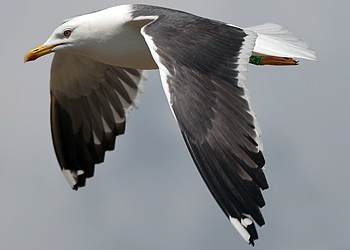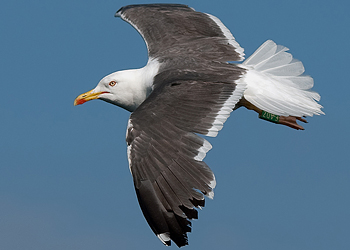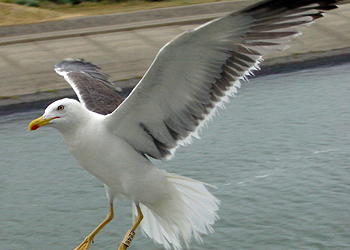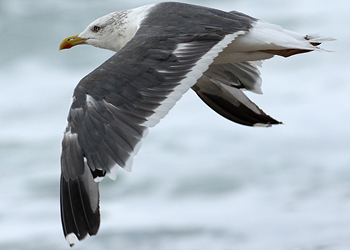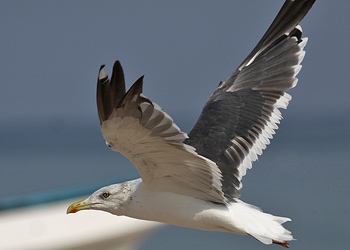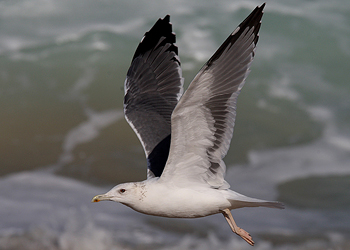 Heuglin's Gull (L. heuglini / antelius)
Heuglin's Gull (L. heuglini / antelius)
(last update:
Amir Ben Dov (Israel)
Chris Gibbins (Scotland)
Hannu Koskinen (Finland)
Mars Muusse (the Netherlands)
3cy heuglini: November
Below you will find a copy of Descriptive update on gull taxonomy: 'West Siberian Gull', by Valery A. Buzun published in British Birds 95 • May 2002 • 216-232. Most of the text below is a copy of that article, but now illustrated with many more birds and figures, and additional data from Dutch samples.
"I" in the text below refers to the original author Buzun. If any errors occur in this text, please let me know and mail to marsmuusseatgmaildotcom.
PART 1 - INTRO & MANTLE COLOUR
PART 2 - PRIMARY PATTERN & BARE PART COLORATION
PART 3 - MORPHOMETRIC & DIMORPHISM
PART 4 - BODY SIZE
PART 5 - PRIMARY MOULT
PART 6 - GEOGRAPHICAL VARIATION
Descriptive update on gull taxonomy: 'West Siberian Gull' - Valery A. Buzun
PART 5
Primary moult
On the Russkii Zavorot peninsula, in 1996, the stage of primary moult differed not only between breeding birds and immatures, but also between those nesting on tundra and those nesting on marine islands.
Of five individuals aged from one to three years, three had begun their primary moult at some time during the first ten days of June. By the end of July, P6 was moulted. For adults, the beginning of primary moult (the loss of P1) occurred between 20th June and 20th July. Consequently, for any given population, there is about one month’s variation among individuals. By the middle of July, 25% of adults nesting on marine islands had moulted P3, whereas 30% of adults nesting on tundra had moulted P4 (and some individuals were even more advanced).
{below: additional data on graellsii and intermedius}
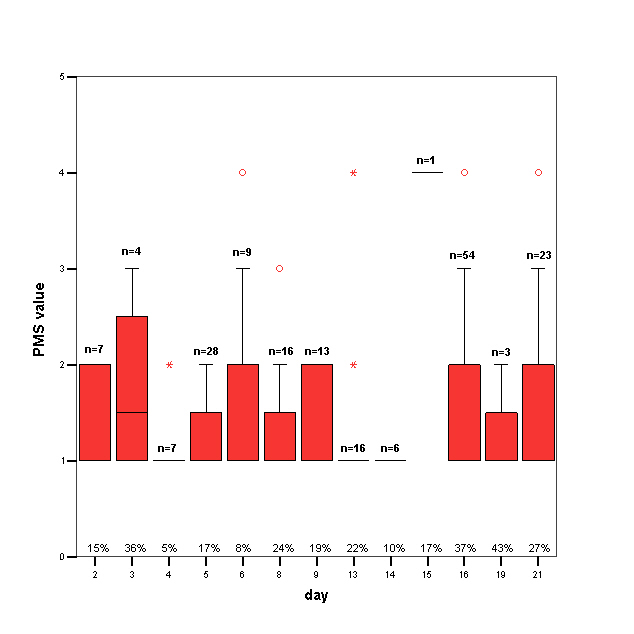
Primary Moult Scores in May for actively moulting Lesser Black-backed Gulls (n = 187, out of 997 birds. 810 birds still not moulting).
01 May = day 1.
o: Outliers.
*: Extremes.
Numbers of actively moulting birds in % along X-axis.
LBBG showing arrested moult not in this figure, for they are not in ‘active moult’.
On day 23, 11 LBBG were all scored PMS0 (no active moult).
Heuglin's Gull, like nominate fuscus, is a long-distance migrant to E Africa and the near-East. At the breeding grounds it appears a late moulting species, and images from the wintering quarters confirm this. It's quite normal to find birds still moulting the outermost primaries in January and even February. Such late moult is not common in the western taxa of fuscus. Late moulting may be a good indication for Heuglin's Gull, but in graellsii and intermedius there hardly is an exact period for moult commencement; some may start moulting in May, but some may wait until August.
(in the graph below, a horizontal line of dots represent the time range in which a moult score was observed, e.g.: PMS=10, is all primaries old, lasted until day 200).
In summer 2003 we scored ringed adult breeding graellsii (>5CY) at Maasvlakte (the Netherlands), Zeebrugge (Belgium), and IJmuiden (the Netherlands). The sample was completed with autumn scoring s on ringed adult graellsii and intermedius (>5CY) from the UK, Belgium, the Netherlands, Germany, Denmark, Norway and Sweden. In total, for 2003 we scored 1114 ringed adults to obtain moult scores (see graph below).
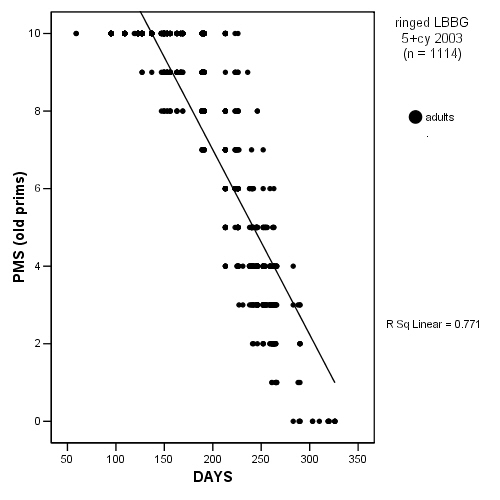
Primary Moult Scores in ringed 5+cy graellsii and intermedius Lesser Black-backed Gulls in 2003 (n = 1114).
01 January = day 1.
Buzun described the primary moult for heuglini at the breeding grounds, with the commencement of the complete moult between 20 June-20 July. By mid July, about 25% of breeding heuglini from the islands has moulted P3, while 30% of the tundra breeding heuglini has moulted P4 or even higher by mid July. For Moerdijk we have no data for the period after May; but trapped birds in May showed only 187 out of 997 birds to have started moult.
The graph below narrows the time period to June-July, to compare data with the finding by Valery. The green dots refer to western LBBG intermedius and graellsii. For the period, we scored 378 ringed adult (5+cy) birds. The green line represents the average moult score in time. The 1st of June can be found on the X axis as day 152. Heuglini breeding on the islands are illustrated in red, heuglini breeding on the tundra is in yellow. The commencement of primary moult is the red triangle, equal to the from mid-June until mid-July.
By mid July, about 25% of breeding heuglini from the islands has moulted P3 (illustrated as P1-P7 still old), while 30% of the tundra breeding heuglini has moulted P4 (illustrated as P1-P6 still old) or even higher by mid July. As can be read from the graph, these groups (25% and 30%) are slightly ahead of the average western LBBG.
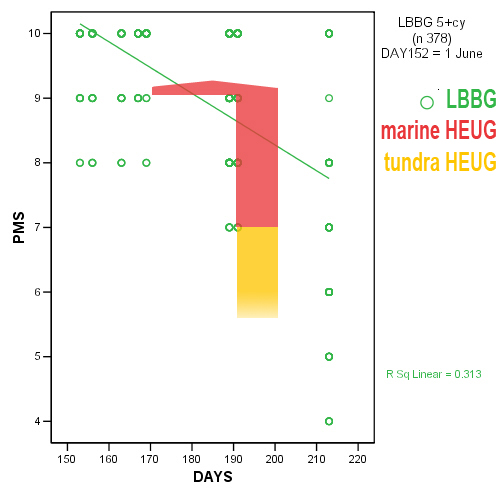
Primary Moult Scores in ringed 5+cy graellsii and intermedius Lesser Black-backed Gulls in June-July 2003 (n = 378) and actively moulting heuglini (25% of the island population, 30% of the tundra population).
01 June = day 152.
For heuglini moult, there is more data available in the literature. Visa Rauste (1999) has scored heuglini in Archangelsk, NW Russia in early-September. His data is represented again in the graph below, together with data we have collected in summer 2003 in the period 28 August - 4 September. Despite the rather small sample size for these populations, it is obvious from the figure that there is a rather large range of moult scores by early September. Secondly, the figures indicate that graellsii is somewhat ahead of intermedius, with less old primaries present; and on average, heuglini is somewhat behind compared to intermedius, with the complete moult only just started in some heuglini (9 old primaries present). But also, there is quite some overlap.

Primary Moult Scores in ringed 5+cy graellsii and intermedius Lesser Black-backed Gulls in the period 28 August - 04 September 2003 (n = 100) and heuglini at Archangelsk, NW Russia.
Finally, the image below represents western LBBG with delayed primary moult. The problem is that such birds may not just be 'the odd individual', but may arrange their moulting in a strategy of first migrating south, and then start moulting (as is commonly seen in nominate fuscus). Still, the timing of such western birds may be earlier in the season than nominate fuscus, as they are not true long-distance migrants. Problem here is that such birds, hypothetically making a rapid migration into Portugal or the coast of W Africa, are hard to find out on the sea, while on the other hand the number of people photographing gulls in W Africa is much lower than in NW Europe. So it will probably take some years before we fully understand the exact moult startegy and timing in autumn western LBBG.
| Below: 2 example birds to show late moult (growing P10) in intermedius Lesser Black-backed Gull. | |
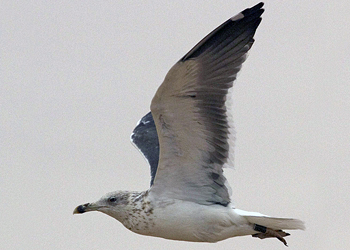 |
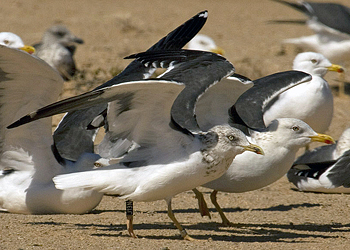 |
| Larus fuscus intermedius JXJ4 4cy, February 09 2012, Layonne rubbish tip, Western Sahara (27°04'18"N 013°23'31"W, Morten Helberg). Black on P4-P10. Extensive head streaking and much black on the bill. P9 fully grown, P10 still growing by February. Note missing inner secondaries, at classic location when the complete moult is to be finished soon. Ringed on July 12 2009 at Rauna, Farsund, Vest-Agder, Norway (58°03'33"N 006°40'10"E), by Marton Berntsen. | Larus fuscus intermedius J13N 6cy, February 07 2012, Dakhla 2, Western Sahara (23°41'35"N 015°57'57"W, Morten Helberg. Dark red orbital ring. Extensive head streaking and much black on the bill. P9 fully grown, P10 still growing by February. Ringed on July 14 2007 at Rauna, Farsund, Vest-Agder, Norway (58°03'33"N 006°40'10"E), by Knut Sigbjørn Olsen. |
 Heuglini 3cy, November 30 2009, northern Oman. Picture: Hans Larsson.
Heuglini 3cy, November 30 2009, northern Oman. Picture: Hans Larsson.